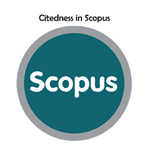Analisis Cemaran Klorin Pada Beras Dengan Metode Volumetri Studi Kasus : Kabupaten Bone Bolango
Abstract
Rice is a staple food because it contains protein needed by the body is a source of energy. Rice that is white and shiny sometimes attracts people's attention. Therefore, to increase buyers' interest, many sellers add bleaching additives such as chlorine ( a chemical to kill germs) without reckoning the side effects that will be inflicted. This study examines the chlorine content in circulated rice in Bone Bolango Regency. This study used seven rice samples to be analyzed through color and precipitation tests. This research implements a mixed method in the form of qualitative as well as Iodometric and Argentometry titrations for quantitative. The results reveal that in the seven rice samples studied, there was no chlorine content due to the absence of discoloration and precipitate. It is supported by the Iodometric and Argentometric tests which show the results of chlorine levels are at 0%.
Keywords
Full Text:
PDFReferences
Nuryani, (2013). Potensi Subtitusi Beras Putih dan Beras merah sebagai Makanan pokok untuk Perlindungan Diabetes Melitus. Malang: Universitas Muhammadiyah.
Wongkar, I. Y., Abidjulu, J., & Wehantouw, F. (2014). Analisis Klorin pada Beras yang Beredar di Pasar Kota Manado. Manado, Jurnal Ilmiah Farmasi.
S. Supriyanto. Ernawati, [2010]. Judul : Pemasaran Industri Jasa Kesehatan. Penerbit CV Andi Offset : Yogyakarta.
Praja, D. I. [2015]. Zat Adiktif Makanan Manfaat Dan Bahayanya. Yogyakarta: Garudhawaca
Ade Maria, U. (2015). Penetapan Kadar Klorin (Cl2) pada Beras menggunakan Metode Iodometri. Jurnal Kesehatan Holistik.
Stefi. (2007). Beras Putih Berpemutih. Diakses 18 Januari 2014
Peraturan Menteri Kesehatan RI No. 1168/Menkes/X/1999. Tentang Perubahan atas Peraturan Menteri Kesehatan No. 772/Menkes/Per/XI/1988. Tentang Bahan Tambahan Makanan
peraturan menteri pertanian Republik Indonesia Nomor 32/Permentan/OT.140/3/2007 tentang perlarangan penggunana bahan kimia berbahaya pada proses penggilingan padi, huller dan penyosohan beras.
Norlatifah. (2012). Identifikasi Klorin secara Kualitatif Pada Beras yang di Jual di Pasar Besar Kecamatan Pahandut Palangkaraya. Medan : Universitas Sumatera Utara. 42
Asrina, R. Anganria, J. (2019). Analisis Kualitatif Klorin (Cl2) pada Beras Putih yang beredar di pasar tradisional daya kota Makassar. Jurnal Farmasi Sandi Karsa. 5(1).
Supriyanto, & Purwaningsih, I. (2017). Personal hygiene terhadap infeksi pityriasis versikolor pada nelayan di desa penjajap kecamatan pemangkat, 1(1).
Sinuhaji.D.N. (2009).Perbedaan Kandungan Klorin (Cl) Pada Beras Sebelum dan Sesudah Dimasak. Penerbit : Universitas Sumatra Utara, Medan.
Prayoga, T. Mekasari, N. (2016). Identifikasi Boraks Pada Bakso di Kelurahan Bahagia Bekasi Utara Jawa Barat dengan Metode Analisis Kualitatif. Jurnal Akademi Farmasi IKIFA. Vol 01(01):113-120
Diah Ayu, N,R. Mely, p. (2018). Determination of rate chloride (Cl2) with Argentometric Mohr on Drinking Water refill Tidiness in the Vilage Purwodadi Districts kras Regency Kediri. Department Of forensic Science. Universitas Airlangga.
Kurniawan. (2014). Identifikasi Zat Klorin pada Beras Putih di Pasar Kahayan Kota Palangkaraya. Palangkaraya: Universitas Muhammadiyah Palangkaraya. Jurnal Kesehatan Masyarakat.
DOI: https://doi.org/10.37311/ijpe.v3i2.18611
Refbacks
- There are currently no refbacks.
Copyright (c) 2023 siti nuraini bahar

Indonesian Journal of Pharmaceutical Education is licensed under a Creative Commons Attribution-NonCommercial-ShareAlike 4.0 International License.



